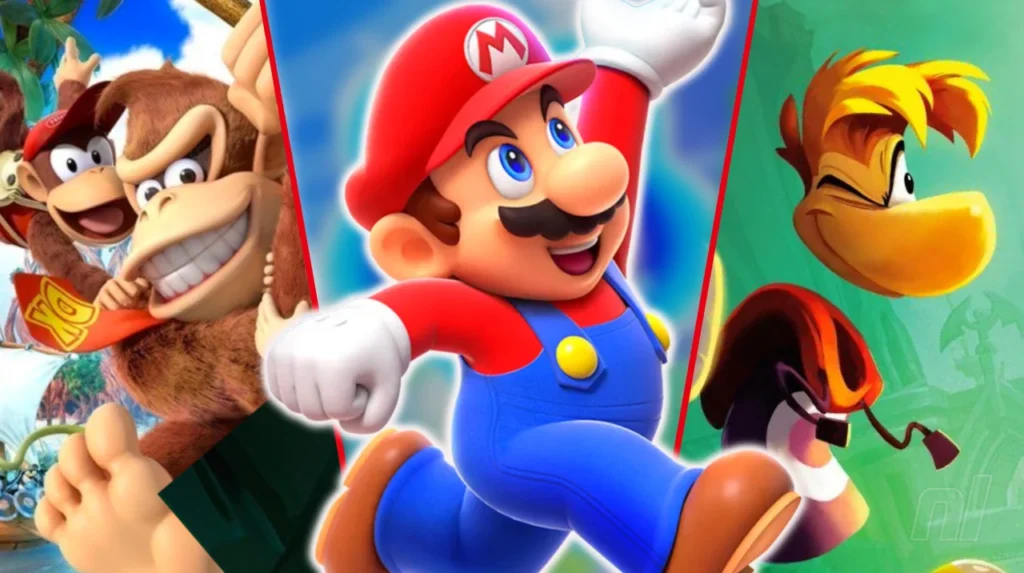In the vibrant tapestry of video game history, platformers have carved out a special place, captivating players with their blend of agility, strategy, and imagination. These games, characterized by their simple yet challenging mechanics, have evolved remarkably since their inception. From the early days of Mario hopping across pixelated landscapes to modern masterpieces that push the boundaries of storytelling and design, platformers have consistently enthralled gamers of all ages. This article delves into the rich history of platformers, exploring their roots, evolution, and enduring appeal.
The Golden Age of Platformers: Mario’s Reign
The story of platformers truly begins with one name: Mario. Introduced in 1981’s “Donkey Kong” and later starring in 1985’s “Super Mario Bros.,” Mario became the face of Nintendo and a global icon. “Super Mario Bros.” was revolutionary, transforming the gaming landscape with its side-scrolling action, intuitive controls, and imaginative level design. Players were transported to the whimsical Mushroom Kingdom, where they guided Mario through perilous platforms, avoided Goombas, and rescued Princess Peach from the clutches of Bowser. This game didn’t just entertain; it set a standard for future platformers and established Nintendo as a dominant force in the industry.
The success of “Super Mario Bros.” sparked a golden age of platformers in the late 1980s and early 1990s. Titles like “Mega Man,” “Sonic the Hedgehog,” and “Castlevania” followed, each bringing unique elements to the genre. “Mega Man” introduced complex levels and challenging boss battles, while “Sonic the Hedgehog” captivated players with its speed and vibrant graphics. “Castlevania” blended action with horror, setting the stage for the Metroidvania subgenre. These games were not only popular, but also critically acclaimed, influencing countless developers and cementing platformers as a cornerstone of video game culture.
Innovation and Diversification in the Platformer Genre
As the gaming industry progressed, platformers evolved, embracing new technologies and ideas. The mid-1990s saw the advent of 3D graphics, revolutionizing the genre. “Super Mario 64,” released in 1996 for the Nintendo 64, was a groundbreaking title that redefined what platformers could be. Players were no longer confined to side-scrolling environments; they could explore vast, open worlds with unprecedented freedom. The game’s innovative use of a 3D camera and analog stick controls set new standards and inspired a generation of 3D platformers, including “Banjo-Kazooie” and “Spyro the Dragon.”
Parallel to the rise of 3D platformers, the indie gaming scene began to flourish, bringing fresh perspectives and creativity to the genre. Titles like “Braid” and “Celeste” demonstrated that platformers could tell deeply personal stories and tackle complex themes. “Braid,” with its time-manipulation mechanics and thought-provoking narrative, challenged players to think beyond traditional gameplay. “Celeste,” on the other hand, combined tight controls and challenging levels with a touching story about mental health, earning widespread acclaim. These indie games proved that platformers could evolve and remain relevant by exploring new concepts and pushing artistic boundaries.

Modern Classics: The New Era of Platformers
Today, platformers continue to thrive, blending nostalgia with innovation. Modern classics like “Hollow Knight” and “Ori and the Blind Forest” exemplify the genre’s enduring appeal. “Hollow Knight,” with its hand-drawn art and intricate world, offers a deep, immersive experience that harkens back to the Metroidvania roots while introducing new elements like intense combat and expansive lore. Its challenging gameplay and atmospheric design have captivated players, solidifying its status as a modern classic.
“Ori and the Blind Forest” is another standout, praised for its stunning visuals, emotional storytelling, and fluid gameplay. The game’s beautiful, hand-painted environments and meticulously crafted soundtrack create an enchanting experience. Its sequel, “Ori and the Will of the Wisps,” expanded on these strengths, delivering an even more polished and engaging adventure. These games exemplify how modern platformers can blend artistic excellence with gameplay innovation, capturing the hearts of both new players and longtime fans of the genre.
Conclusion: The Everlasting Charm of Platformers
From the pixelated adventures of Mario to the intricate worlds of modern classics, platformers have come a long way. Their ability to evolve while retaining the core elements that make them fun and engaging is a testament to their lasting appeal. As technology advances and new creative voices emerge, the platformer genre will undoubtedly continue to surprise and delight players. Whether through the nostalgic charm of retro titles or the innovative brilliance of new releases, platformers remain a beloved and integral part of the gaming world, inspiring players and developers alike.`


